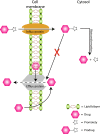Ocular drug delivery
- PMID: 20437123
- PMCID: PMC2895432
- DOI: 10.1208/s12248-010-9183-3
Ocular drug delivery
Abstract
Ocular drug delivery has been a major challenge to pharmacologists and drug delivery scientists due to its unique anatomy and physiology. Static barriers (different layers of cornea, sclera, and retina including blood aqueous and blood-retinal barriers), dynamic barriers (choroidal and conjunctival blood flow, lymphatic clearance, and tear dilution), and efflux pumps in conjunction pose a significant challenge for delivery of a drug alone or in a dosage form, especially to the posterior segment. Identification of influx transporters on various ocular tissues and designing a transporter-targeted delivery of a parent drug has gathered momentum in recent years. Parallelly, colloidal dosage forms such as nanoparticles, nanomicelles, liposomes, and microemulsions have been widely explored to overcome various static and dynamic barriers. Novel drug delivery strategies such as bioadhesive gels and fibrin sealant-based approaches were developed to sustain drug levels at the target site. Designing noninvasive sustained drug delivery systems and exploring the feasibility of topical application to deliver drugs to the posterior segment may drastically improve drug delivery in the years to come. Current developments in the field of ophthalmic drug delivery promise a significant improvement in overcoming the challenges posed by various anterior and posterior segment diseases.
Figures
References
-
- Ananthula HK, Vaishya RD, Barot M, Mitra AK. Duane's Ophthalmology. In: Tasman W, Jaeger EA, editors. Bioavailability. Philadelphia: Lippincott Williams & Wilkins; 2009.
-
- Ahmed I. The noncorneal route in ocular drug delivery. In: Mitra AK, editor. Ophthalmic drug delivery systems. New York: Marcel Dekker; 2003. pp. 335–63.
Publication types
MeSH terms
Substances
Grants and funding
LinkOut - more resources
Full Text Sources
Other Literature Sources



